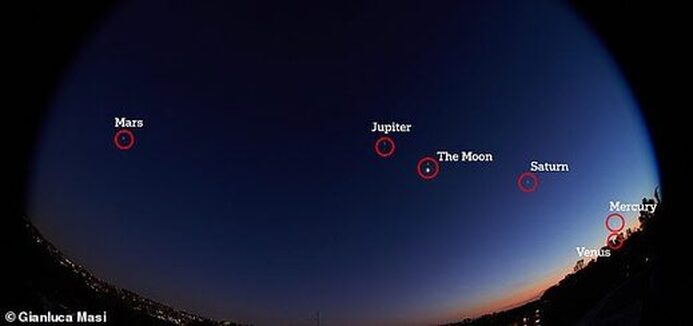Dr Gianluca Masi took the image from the roof of the building where he lives last night, using a camera with special lenses. It shows Venus, Mercury, Saturn, Jupiter, Mars and the Moon
Mercury, Venus, Mars, Jupiter and Saturn can all be seen with the naked eye, while Uranus and Neptune are possible to spot with binoculars or a telescope.
Astronomer Dr Gianluca Masi shared a picture he took of the five planets that could be seen with the naked eye, while other skywatchers across the world also captured images of the 'planet parade'. He took it from the roof of a building in Rome, Italy last night, using a camera with special lenses.
The solar system will put on a show for space fans for the next two evenings, with all seven planets other than Earth visible in the night sky
Dr Masi, who works with the Virtual Telescope Project, told MailOnline: 'The opportunity to see all the planetary family at a glance does not happen often.
'We can get a better idea of the cosmic place where we live by looking at the other planets. We have just a couple of days to look at this parade, before Mercury will disappear into the solar glare.'
This week, Twitter users from across the globe, including Japan and the US, have been sharing photos of the spectacle online. The phenomenon is known to occur about once every two years.
All planets appeared in the night sky as small points of light to stargazers in the northern hemisphere. Mercury is the hardest planet to see without magnification, as it is sitting in a bright part of the sky, however it can be spotted close to the much brighter Venus which outshines it by 70 times.
Tonight, the two reach conjunction - their closest point - at 21:00 GMT (16:00 ET), and they won't appear this close again until 2024.





 RSS Feed
RSS Feed